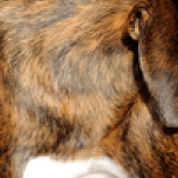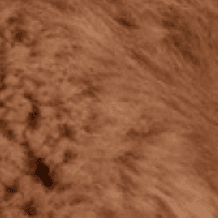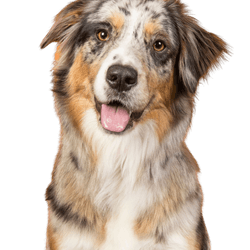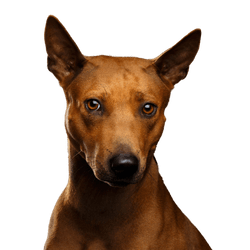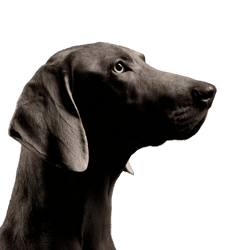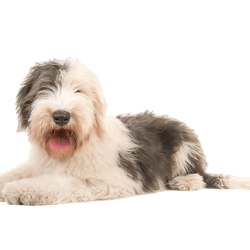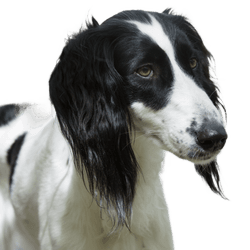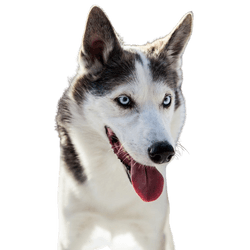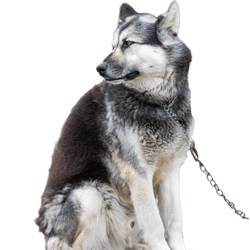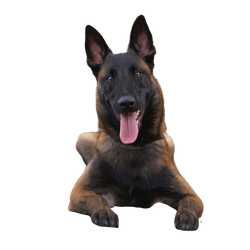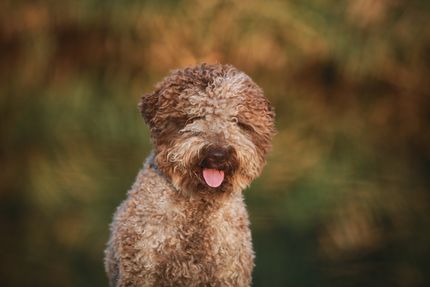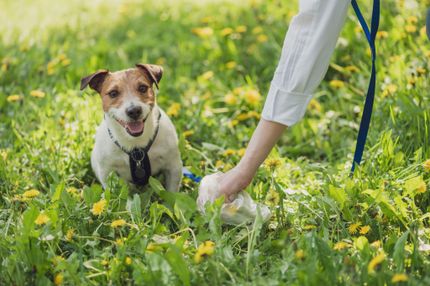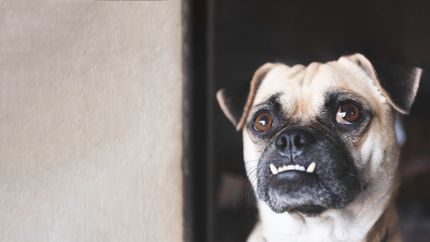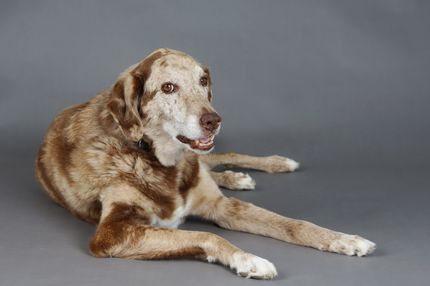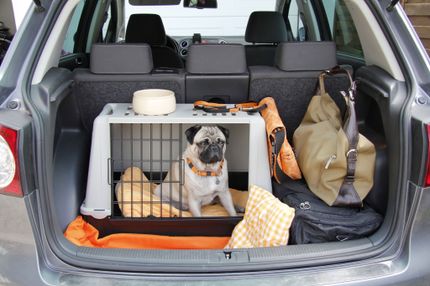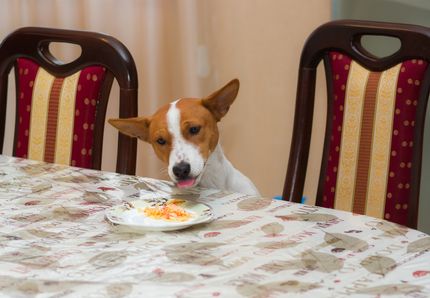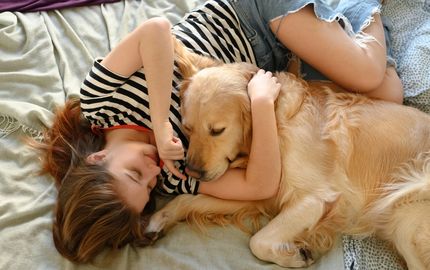Facts & Origin
Basic information about the Mastiff
The Mastiff is a recognized British dog breed. It is often referred to as the largest breed in the world with an average weight of 90kg. The appendage "Old English" can be added, as there are many other breeds that also have "Mastiff" in their name - many of which, such as the Bullmastiff, it has influenced. So a synonym for the Mastiff is the Old English Mastiff.
A representative of this breed "Aicama Zorba La-Susa", who died at the age of 11 in 1992, carried the record as the heaviest dog in the world. He weighed 155 kg in 1989 with a height at withers of 95 cm without excess weight.
History and origin
The name first appears as "Maystif" in the 14th century in the royal treatise "The Master of the Game and of Hawks" by Edmund of Langley, which he wrote for Henry IV. Etymologically, "Mast-teve" meaning "weighty, clumsy" from Low German and the Latin "mixtivus" meaning "mongrel" come into consideration. In 1991, Prof. Reul derived the English "mastiff" from Latin "matinus" and translated this as "domestic, tame".
The English Mastiff is considered the ancestor of various dog breeds that exist today, such as, to name a few, the Great Dane or the Boxer. In the history of the Mastiff, which goes back to Roman times, the following four attributes were attributed to the Mastiff in particular:
- British,
- a forehead covered with wrinkles,
- a wide mouth,
- a massive physique.
The history of the mastiff is as rich and varied as it is inaccurate and controversial. Originally, the mastiff comes from Great Britain. However, the exact origin is disputed, and there are several theories. Older theories refer to the Tibetan Dogue or Tibetan Mastiff as the ancestor, while others dub him an original breed, formed indigenously and without human influence. The theory that the mastiff is a mix of Tibetan dogs and Britannian dogs is not considered likely. Another theory is that the historical Mastiff is a descendant of the Molossian from Macedonia and Epirus, which arrived in England as sea cargo.
As for the historical past of this dog breed, they were used particularly as hunting and guard dogs, as well as in war. As Shaw put it, "A Mastiff of true English blood loved battle more than his food. His glory was seen in his limping step, scars from fighting for honor marked his face; on every limb a scrape, frequent fighting shortened his ears!" (Shaw, 1891). The Mastiff was first documented as a dog in warfare in 1415, when the Battle of Azincourt was raging. It is said that a massive dog protected its wounded master from attack.
Due to their special strength and robustness, Mastiffs were even successful in hunting overpowering opponents such as bulls, bears or wild boars. A record of a fight that took place between a bear and six dogs dates back to 1050. Also in the Elizabethan age, it was quite possible that doggen-type dogs competed in arenas against predators. Breeding in the modern understanding began around 1820.
William Shakespeare and the Mastiff
Those who like larger dogs and do not shy away from those that are among the largest and heaviest in the world can get an Old English Mastiff if all the important criteria are met - and will experience a deep bond of a very special kind. Or as William Shakespeare said in Henry V: "That island of England breeds very valiant creatures; their mastiffs are of unmatchable courage" (Act 3, Scene 7).
Suitability and attitude
The Mastiff is bred as a guard and watch dog. At the same time, he is not very athletic and therefore less suitable for dog sports. Regular walks are enough for most specimens of this breed. However, due to its good nature, it can also be kept as a family dog.
The Mastiff as a listed dog
In Germany, the Mastiff can be regionally classified as dangerous. You can get more detailed information about your place of residence at the local authority.
Austrian dog owners need a special permit to keep the Mastiff in the provinces of Vienna and Vorarlberg.
The Swiss cantons of Geneva and Valais have completely banned keeping, breeding and importing the breed. In Fribourg, Schaffhausen, Thurgau and Ticino you need a special permit for keeping.
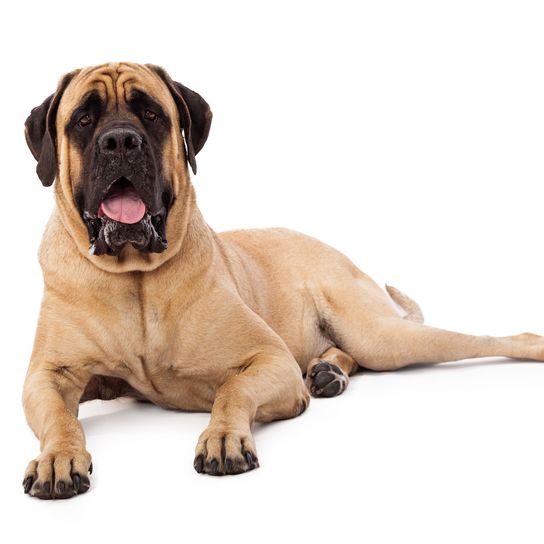
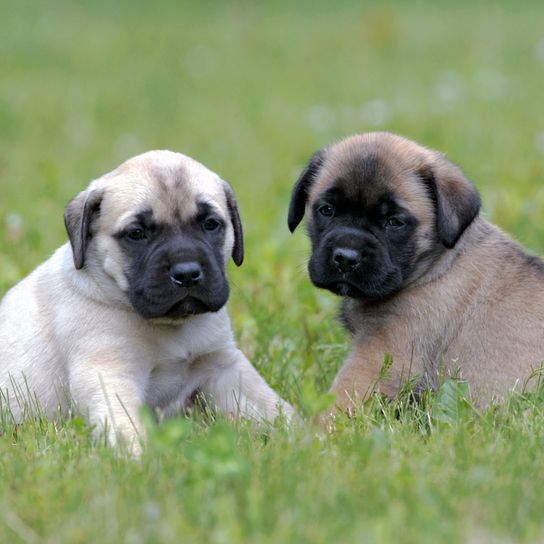
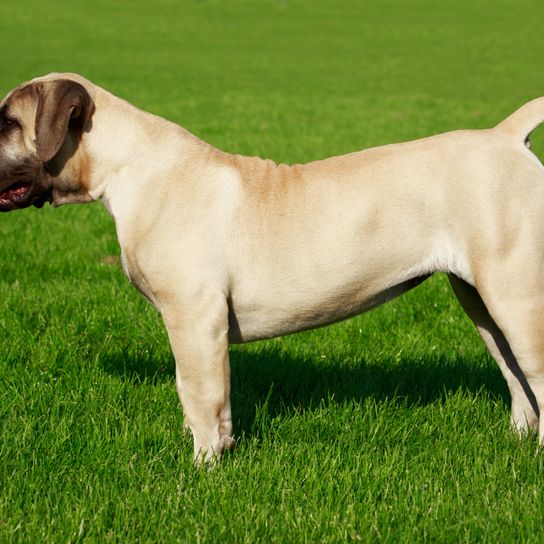
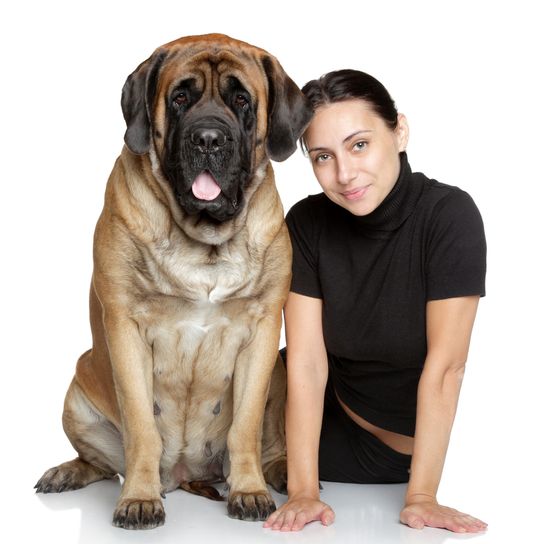
| Alternate Name | Old English Mastiff |
| Origin | UK |
| Life expectancy | 6 - 12 years |
| Care requirements | low-maintenance |
| Activity level | average |
| FCI group | Molossian type |
| AKC group | Herding Group |
| KC group | Pastoral Group |
Mastiff mixes
Attitude, character and temperament of the breed
Typical character traits of the Mastiff
A Mastiff is loyal to the death - at least that's what old legends said. Fortunately, today we live in quite peaceful times and so this dog can concentrate more on cuddling than on fighting. Mastiffs are affectionate and lovable creatures, if you know how to understand them properly. But if you are afraid of the Mastiff, he will automatically become suspicious. You definitely can't wrestle for right and supremacy in the pack with this dog. Therefore, it is important to start early with a consistent but patient education.
You should be able to offer this dog a house with ground level access and a large garden. He likes to lie outside in the nature and to guard something. If you train him to exercise regularly at an early age, he will gladly accompany you on leisurely walks.
Overall, these dogs are considered very people-friendly. The Mastiff only came into disrepute with us because questionable owners wanted to make themselves important with him; therefore he can be found on some breed lists today. The following characteristics are attributed to the Old English Mastiff:
- calm
- harmonious
- faithful
- good-natured
- balanced/calm
- reserved
- attentive
- peaceable/ very high irritation threshold
- fixated on his "pack", his family
Education of the Mastiff
Old English Mastiffs require consistent and gentle training. They are suitable for experienced dog owners and therefore less recommended for as a first dog. In addition to lots of attention and affection, the Mastiff especially needs enough exercise. If you want to get a Mastiff, it is best to have a large house with a garden. Small apartments without a garden are less suitable.
Character
Usage
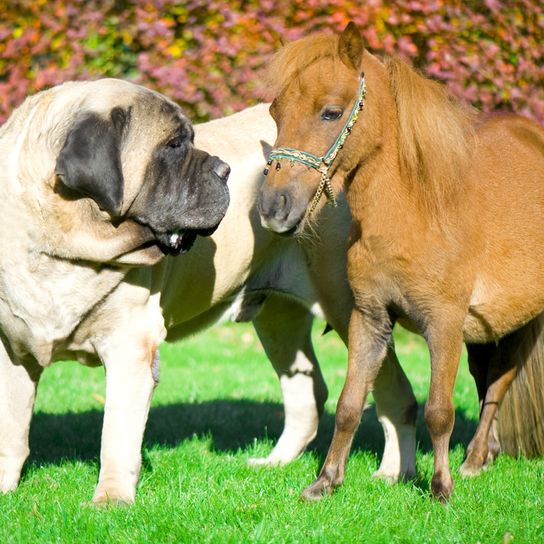
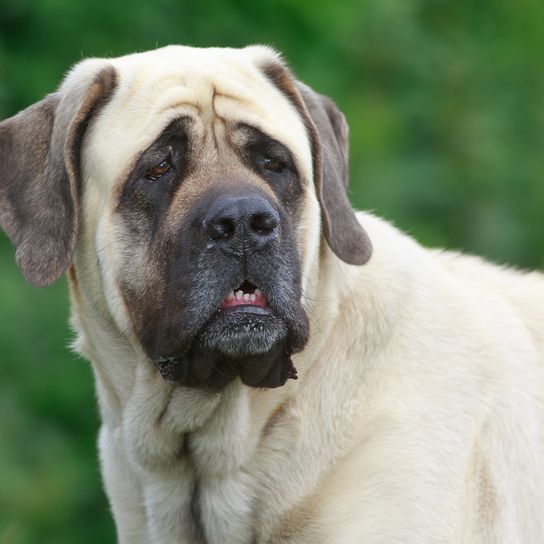
Breed diseases of the Mastiff
For diseases affecting the heart or the eyes, the Mastiff has developed an increased susceptibility in the course of breeding. Due to its size and weight, it can also often develop hip and elbow joint problems. Mastiffs are also prone to stomach upsets, so it is better to feed them smaller portions of food several times a day. To date, dogs of this breed have known more common heart problems and skin problems due to wrinkles. Both may still be a legacy of overbreeding, depending on the breed.
Life expectancy
The average life expectancy is about 8 to 10 years. Larger dogs tend to have a shorter life expectancy than smaller ones. Nevertheless, with proper care and attention, the Mastiff can happily reach an age of up to 14 years.
Mastiff breeding and purchase
For breeding, the FCI standards are decisive. It is important that all species-appropriate criteria are met, only then can a reputable breeder be identified. Historically, pure breeding began around 1820 or 1835 in England. At that time there was disagreement about the appearance and color. In 1872 the Mastiff Club was founded. St. Bernards with smooth coats were crossed in. The Mastiff is also listed in the Club für Molosser e. V..
You can get a Mastiff puppy from a good breeder. But these dogs are expensive. You have to calculate with about 1500 Euro.
If you want to adopt a Mastiff, you might find a suitable animal at "Molosser in Not".

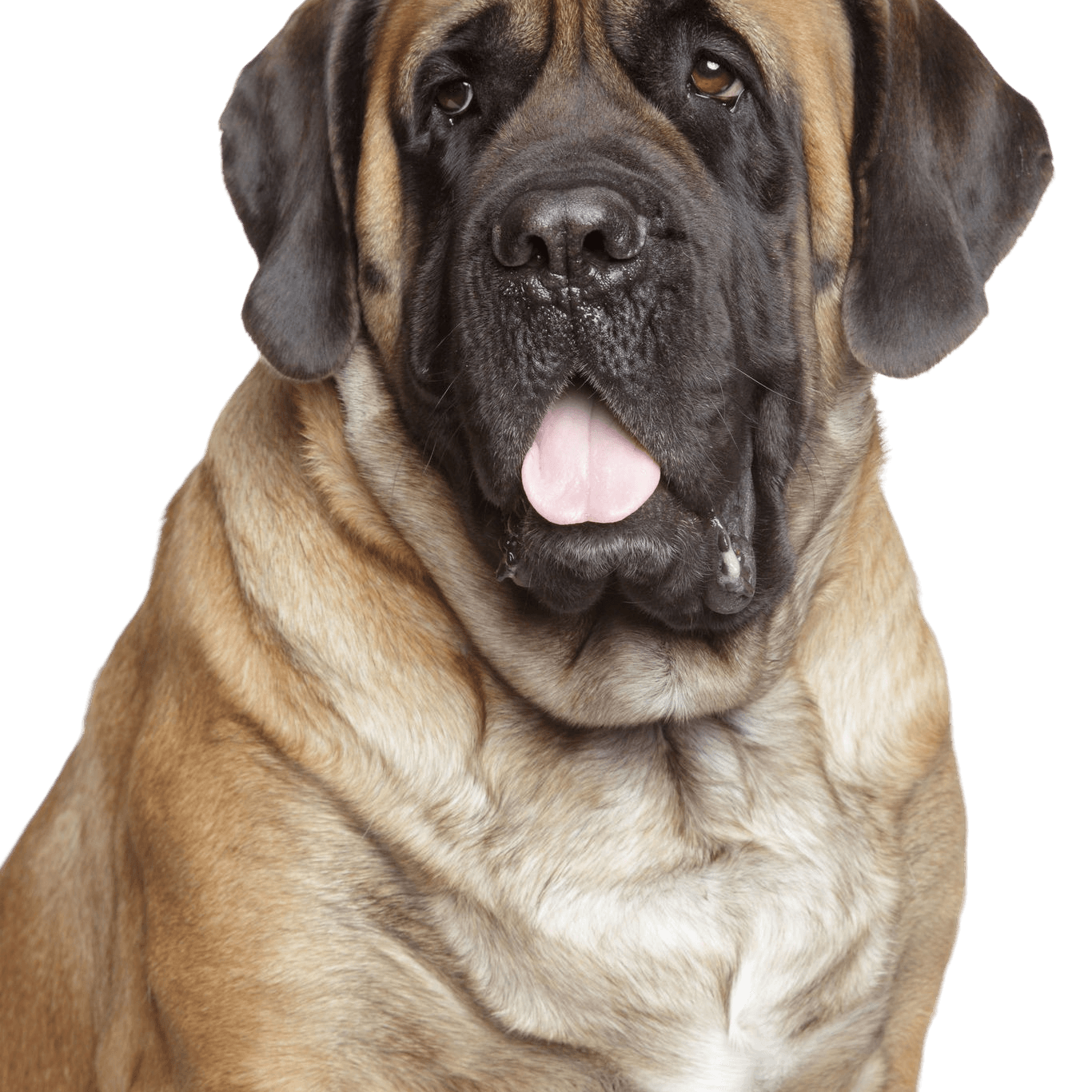
Breed characteristics of the Mastiff
The Mastiff is classified by the FCI as Group 2 (Pinscher and Schnauzer - Molossoid - Swiss Mountain and Cattle Dogs), Section 2.1 (Great Dane-type dogs). No working test is required.
According to the breed standard, size is desirable, but only if it is combined with quality and if total health is maintained. Height and substance should be related. A female is usually at least 65 cm tall, while the male is at least 75 cm tall. The weight can be 60 - 85 kg for bitches and 80 - 110 kg for males. Variations are of course possible.
The gait
Powerful, effortless ground covering, with thrust from behind, fluid with ground covering strides. The topline remains straight during movement. The tendency to pass gait is undesirable. Absolutely sound gait is essential.
The head
The skull is broad between the ears and the forehead basically level, but wrinkled when the dog's attention is attracted. The eyebrows should be slightly raised and the stop between the eyes pronounced, but should not appear too abrupt. The arch across the skull shows a flattened curve with a furrow lying between the eyes and extending out to the half sagittal suture.
The muzzle
The black nose is broad, with - viewed from the front - wide open nostrils. In profile, the nose is flat and therefore not upturned. The muzzle itself is short, broad under the eyes, almost constant in width to the tip of the nose, blunt and square cut. Thus it forms a right angle with the bridge of the nose and there is an enormous depth from the tip of the nose to the broad lower jaw.
The length of the muzzle in relation to the whole of the skull and foreface is equal to about 1 : 3. The circumference of the muzzle (measured midway between the eyes and the tip of the nose) in relation to the circumference of the head (measured in front of the ears) is about 3 : 5. At rest, any exaggeration of folds or excessive skin is unacceptable in adult dogs.
The lips extend from the nasal septum at an obtuse angle, but are slightly pendulous, forming a square profile. The incisors form an exact dental occlusion of the pincer bite (from one corner to the other corner) or the lower row of teeth is in front of the upper row of teeth (forebite). However, the latter must never be so strong that the lower incisors would be visible when the muzzle is closed. The temporal and cheek muscles (temporal bone and masseter) should be well developed.
The eyes & ears
The eyes are of medium size, set wide apart. Their color corresponds to a hazel, the darker the better, and the nictitating membrane must not be visible. Likewise, loose eyelids are highly undesirable as well as other noticeable eye problems.
Small, feel thin, set wide apart at the highest point on either side of the skull so that the line continues across the highest point of the skull. Flat and close to the cheeks when the dog is relaxed.
The rump
The very muscular neck is slightly arched with a circumference about 2.5 to 5 cm less than the circumference of the head (measured in front of the ears). The upper profile line should correspond to a straight line and run over a broad, muscular back and loins which are flat and very broad in females, slightly arched in males.
The broad chest is deep and well laid between the forelegs, the ribs are arched and well rounded, with the rear ribs deep and reaching well back to the hips. The lower profile line shows that the flanks are extremely low.
The tail
The Mastiff tail is high set, reaching to the hocks or a little longer. Broad at the base, it tapers to a point at the end. When at rest it is carried hanging straight down and when excited it is carried curved with the tip pointing upwards. The tail must not be carried raised above the topline.
The limbs
In general, the forequarters appear balanced and in harmony with the broad hindquarters. The shoulder and upper arm are both slightly sloping, heavy and muscular. The elbow is parallel to the body, the forelegs are straight, strong and set wide apart with strong bone. Furthermore, Mastiffs have a straight front pastern. Strong hindquarters are of paramount importance, cowhockiness (a malposition) is considered unacceptable in adult dogs. Also desired are well developed lower legs and well angulated, wide set hocks which should be straight in stance and movement.
Both the front and hind feet are characterized as large, round and closed with well arched toes and black nails.
The coat
Mastiffs have close-fitting short hair, but harsh on the neck and shoulders.
Color-wise, it can be found in apricot, fawn or brindle. Regardless of the base color, the muzzle, ears and nose must be black and the eyelids must be black-rimmed, with the black spreading upward between the eyes. Excessive white on the body, chest or feet is unacceptable according to the breed standard.
| Fur length | short |
| Fur | flat coated |
| Ear shape | Floppy Ear |
| Tail | lang |
| Anatomy | hefty |
| Size ♀ | 70 - 91 cm |
| Weight ♀ | 73 - 100 kg |
| Size ♂ | 70 - 91 cm |
| Weight ♂ | 54 - 77 kg |
| Suitable For | - |
Colors



Known Diseases
Hip dysplasia (HD)
Hip dysplasia (HD) is a genetic condition in dogs where the hip joint is not shaped properly. This leads to pain, stiffness and restricted movement.
Elbow dysplasia (ED)
Elbow joint dysplasia is a chronic disease complex of the elbow joint of fast growing dog breeds.
Eye diseases
Often occur with allergies and intolerances.
Damage to the gait
Often seen in severely overweight dogs and heavy breeds.
Skin inflammations
Can be hereditary in certain breeds.
Heart disease
Can occur frequently in dogs and can sometimes be treated with medication.
FAQ
-
Yes, the Mastiff is on the list of dangerous dog breeds in Germany, Austria and Switzerland.
-
A mastiff is quite expensive and can cost up to 2000 euros.
-
Among the largest dog breeds in the world are the Mastiff, Great Dane and Irish Wolfhound.
-
The record for the heaviest dog in the world is held by "Aicama Zorba La-Susa", an English Mastiff who died at the age of 11 in 1992. He weighed 155 kg in 1989 with a height at withers of 95 cm without excess weight.
-
A Mastiff female is usually at least 65 cm tall, while a male is at least 75 cm tall.
-
Mastiffs often weigh between 70-100kg. However, deviations from this are possible.
-
The Mastiff is not a particularly suitable jogging partner, nor is it particularly athletic. Due to its massive size, it is enough with regular walks.
-
A mastiff usually lives for 8-10 years.
-
You have to calculate with about 1500 Euro for a Mastiff puppy. Later, the running costs and the initial equipment (dog bed, harness, etc.) will be added. The Mastiff is certainly not cheap to keep.





